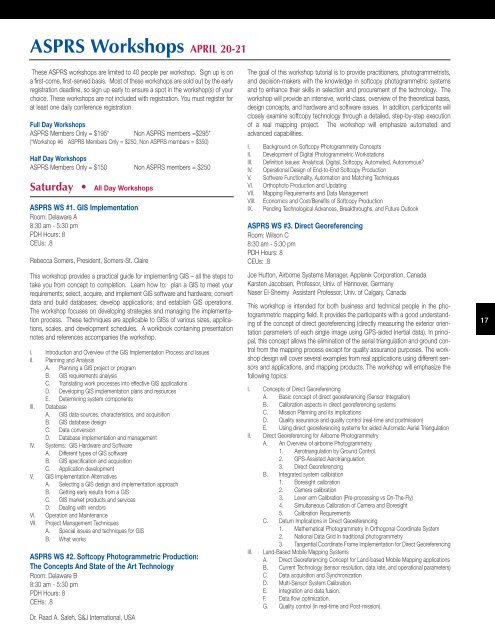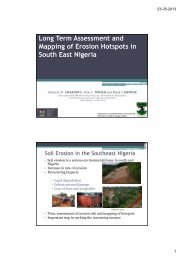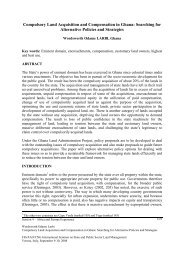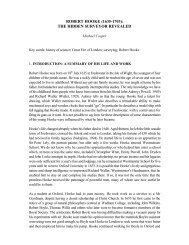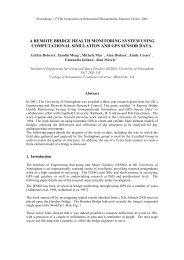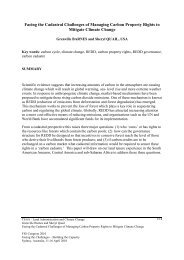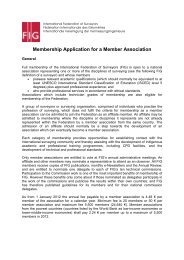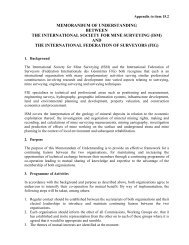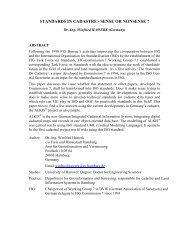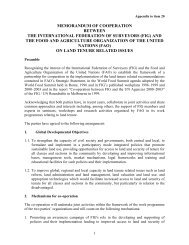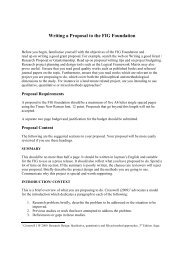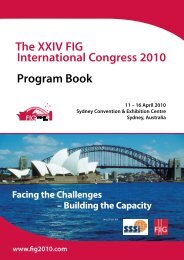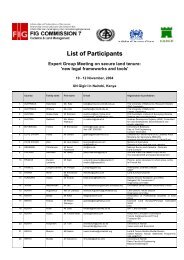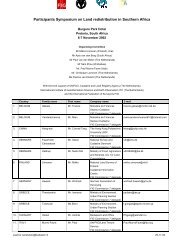You also want an ePaper? Increase the reach of your titles
YUMPU automatically turns print PDFs into web optimized ePapers that Google loves.
ASPRS Workshops APRIL 20-21<br />
These ASPRS workshops are limited to 40 people per workshop. Sign up is on<br />
a first-come, first-served basis. Most of these workshops are sold out by the early<br />
registration deadline, so sign up early to ensure a spot in the workshop(s) of your<br />
choice. These workshops are not included with registration. You must register for<br />
at least one daily conference registration.<br />
Full Day Workshops<br />
ASPRS Members Only = $195* Non ASPRS members =$295*<br />
(*Workshop #6 ASPRS Members Only = $250, Non ASPRS members = $350)<br />
Half Day Workshops<br />
ASPRS Members Only = $150 Non ASPRS members = $250<br />
Saturday • All Day Workshops<br />
ASPRS WS #1. GIS Implementation<br />
Room: Delaware A<br />
8:30 am - 5:30 pm<br />
PDH Hours: 8<br />
CEUs: .8<br />
Rebecca Somers, President, Somers-St. Claire<br />
This workshop provides a practical guide for implementing GIS – all the steps to<br />
take you from concept to completion. Learn how to: plan a GIS to meet your<br />
requirements; select, acquire, and implement GIS software and hardware; convert<br />
data and build databases; develop applications; and establish GIS operations.<br />
The workshop focuses on developing strategies and managing the implementation<br />
process. These techniques are applicable to GISs of various sizes, applications,<br />
scales, and development schedules. A workbook containing presentation<br />
notes and references accompanies the workshop.<br />
I. Introduction and Overview of the GIS Implementation Process and Issues<br />
II. Planning and Analysis<br />
A. Planning a GIS project or program<br />
B. GIS requirements analysis<br />
C. Translating work processes into effective GIS applications<br />
D. Developing GIS implementation plans and resources<br />
E. Determining system components<br />
III. Database<br />
A. GIS data sources, characteristics, and acquisition<br />
B. GIS database design<br />
C. Data conversion<br />
D. Database implementation and management<br />
IV. Systems: GIS Hardware and Software<br />
A. Different types of GIS software<br />
B. GIS specification and acquisition<br />
C. Application development<br />
V. GIS Implementation Alternatives<br />
A. Selecting a GIS design and implementation approach<br />
B. Getting early results from a GIS<br />
C. GIS market products and services<br />
D. Dealing with vendors<br />
VI. Operation and Maintenance<br />
VII. Project Management Techniques<br />
A. Special issues and techniques for GIS<br />
B. What works<br />
ASPRS WS #2. Softcopy Photogrammetric Production:<br />
The Concepts And State of the Art Technology<br />
Room: Delaware B<br />
8:30 am - 5:30 pm<br />
PDH Hours: 8<br />
CEHs: .8<br />
Dr. Raad A. Saleh, S&J International, USA<br />
The goal of this workshop tutorial is to provide practitioners, photogrammetrists,<br />
and decision-makers with the knowledge in softcopy photogrammetric systems<br />
and to enhance their skills in selection and procurement of the technology. The<br />
workshop will provide an intensive, world-class, overview of the theoretical basis,<br />
design concepts, and hardware and software issues. In addition, participants will<br />
closely examine softcopy technology through a detailed, step-by-step execution<br />
of a real mapping project. The workshop will emphasize automated and<br />
advanced capabilities.<br />
I. Background on Softcopy Photogrammetry Concepts<br />
II. Development of Digital Photogrammetric Workstations<br />
III. Definition Issues: Analytical, Digital, Softcopy, Automated, Autonomous?<br />
IV. Operational Design of End-to-End Softcopy Production<br />
V. Software Functionality, Automation and Matching Techniques<br />
VI. Orthophoto Production and Updating<br />
VII. Mapping Requirements and Data Management<br />
VIII. Economics and Cost/Benefits of Softcopy Production<br />
IX. Pending Technological Advances, Breakthroughs, and Future Outlook<br />
ASPRS WS #3. Direct Georeferencing<br />
Room: Wilson C<br />
8:30 am - 5:30 pm<br />
PDH Hours: 8<br />
CEUs: .8<br />
Joe Hutton, Airborne Systems Manager, Applanix Corporation, Canada<br />
Karsten Jacobsen, Professor, Univ. of Hannover, Germany<br />
Naser El-Sheimy Assistant Professor, Univ. of Calgary, Canada<br />
This workshop is intended for both business and technical people in the photogrammetric<br />
mapping field. It provides the participants with a good understanding<br />
of the concept of direct georeferencing (directly measuring the exterior orientation<br />
parameters of each single image using GPS-aided Inertial data). In principal,<br />
this concept allows the elimination of the aerial triangulation and ground control<br />
from the mapping process except for quality assurance purposes. The workshop<br />
design will cover several examples from real applications using different sensors<br />
and applications, and mapping products. The workshop will emphasize the<br />
following topics:<br />
I. Concepts of Direct Georeferencing<br />
A. Basic concept of direct georeferencing (Sensor Integration)<br />
B. Calibration aspects in direct georeferencing systems<br />
C. Mission Planning and its implications<br />
D. Quality assurance and quality control (real-time and postmission)<br />
E. Using direct georeferencing systems for aided Automatic Aerial Triangulation<br />
II. Direct Georeferencing for Airborne Photogrammetry<br />
A. An Overview of airborne Photogrammetry<br />
1. Aerotriangulation by Ground Control.<br />
2. GPS-Assisted Aerotriangulation<br />
3. Direct Georeferencing<br />
B. Integrated system calibration<br />
1. Boresight calibration<br />
2. Camera calibration<br />
3. Lever arm Calibration (Pre-processing vs On-The-Fly)<br />
4. Simultaneous Calibration of Camera and Boresight<br />
5. Calibration Requirements<br />
C. Datum Implications In Direct Georeferencing<br />
1. Mathematical Photogrammetry in Orthogonal Coordinate System<br />
2. National Data Grid in traditional photogrammetry<br />
3. Tangential Coordinate Frame Implementation for Direct Georeferencing<br />
III. Land-Based Mobile Mapping Systems<br />
A. Direct Georeferencing Concept for Land-based Mobile Mapping applications<br />
B. Current Technology (sensor resolution, data rate, and operational parameters)<br />
C. Data acquisition and Synchronization<br />
D. Multi-Sensor System Calibration<br />
E. Integration and data fusion.<br />
F. Data flow optimization.<br />
G. Quality control (in real-time and Post-mission).<br />
17


